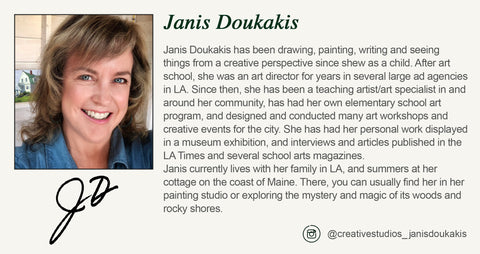Marc Chagall Mixed Media Art Lesson for Kids

A mixed media art lesson for kids celebrating the art of Marc Chagall.
“Art must be an expression of love, or it is nothing.”
– Marc Chagall 1887–1995

A mixed media lesson plan for grades 4 – 6, completed in 3 45 minute class periods.
Students learn about the life of the famous artist Marc Chagall, and create a stunning mixed media “window painting” self-portrait collage.
Materials:
Playing & Learning Oil Pastels
Playing & Learning Connector Paint Box
Playing & Learning World Colors EcoPencil Colored Pencil
Nasco School Grades Watercolor Paper 18 x 24 (pack of 100)
large flat, soft, paintbrush, small round detail brush
pencil
scissors
Vocabulary:
mixed media, bleed, ethereal, semi-transparent, complement, smudge, fluid lines
National Core Art Standards - Visual:
Creating
Anchor Standard #1: Generate and conceptualize artistic ideas and work. Anchor Standard #3: Refine and complete artistic work
Presenting
Anchor Standard #5: Develop and refine artistic techniques and work for presentation
Responding
Anchor Standard #8: Interpret intent and meaning in artistic work
Through The Window
Views of Marc Chagall’s Life and Art
By Barb Rosenstock, Illustrated by Mary Grandpre

Through The Window is a wonderful introduction to Mark Chagall, one of the greatest artists of the 20th century. Since his early years, Marc was fascinated by views through windows, and often used this idea to make “window paint- ings,” telling stories by painting scenes of his child- hood, and places he had lived, often including images of his loved ones. His work was emotional and poetic, colorful and unique, often involving
dreamlike imagery, with people, animals and objects floating in the sky. Chagall used a variety of artistic styles such as cubism, surrealism, along with a variety of mediums throughout his career.
In this lesson plan, students will learn some exciting and effective art techniques with a variety of materials to create a very unique piece of art– a portrayal of themselves, including images of meaningful things in their life, all inspired by Marc Chagall of course.

The Background
Begin by having students use a pencil to lightly draw simple curtain shapes on the sides of a 18 x 24 vertical piece of watercolor paper.
Next, show them how to brush on a light coat of water to the entire paper and paint watery cool blue and violet paint onto the wet background staying inside of the curtain pencil lines. Demonstrate how to use their brush to lightly push the paint around, creating exciting movement with swirling strokes. Let dry.
Show students how to create a soft, ethereal effect to the painted background by rubbing the sides of a white pastel stick on top of the watercolor. Use smaller, broken pieces (without the paper) to blend and soften the paint.

Curtains
Begin by having students first wet their curtains with water and then paint them a solid dark blue. After about 3 minutes, while the paint is still slightly wet, demonstrate how to paint the sheer, white scalloped curtain over the blue. Make sure that the white paint is just the right watery consistency to create a semi- transparent effect on the blue.
When the curtains are dry, show students how to use a small brush to outline the scalloped edges in a less watery white paint, and loosely paint the designs on the white curtain.

Facial Features: Show students how to draw expressive, graphic almond shaped eyes looking to the left or right, up or down. Drawing the brow/nose in this stylized way looks good, and provides plen- ty of opportunity for drawing their own unique nose shape!!
Drawings: Show students how to lightly draw all of their figures and images on a separate white piece of watercolor paper, using curving, fluid lines. Explain that the shapes are floating in a soft, dreamscape. Clothing and hair can be their own ideas. Suggest they also draw their pet and whatever other personal objects or images represent their life and interests. Encourage them to keeps their drawings simple. Don’t forget the moon!
Paint, Pencil and Pastel

Next, students begin to paint their images by first wetting the images with water, and then adding color. Talk about choosing colors that will stand out, and complement the background. Let dry. Soften color with white pastel.

Here, students choose their personal skin toned colored pencil and color their face, hands and feet. For the facial features, have them choose a colored pencil that matches the pastel outline, and go over features previously drawn in pencil.

Demonstrate how to use a pastel to outline the images with a thick line. Next, soften the line by smudging (rubbing over) it with white pastel.
Finally, have students carefully cut out their figures on the outside of the fat pastel line.

Assemble
Demonstrate how to arrange the figures onto the background before gluing. Encourage students to have fun experimenting with positioning the elements in a playful way– things are floating, even upside-down!
Finally, demonstrate how to add stars to their own dreamy self-portrait/ window painting scene with white paint.
Download the entire lesson plan here!


